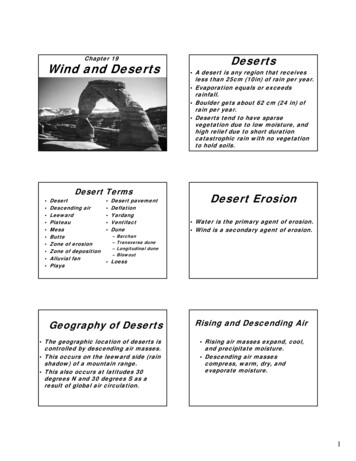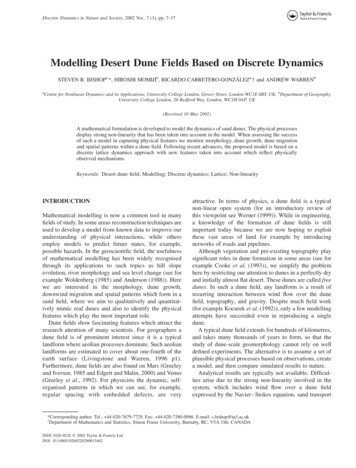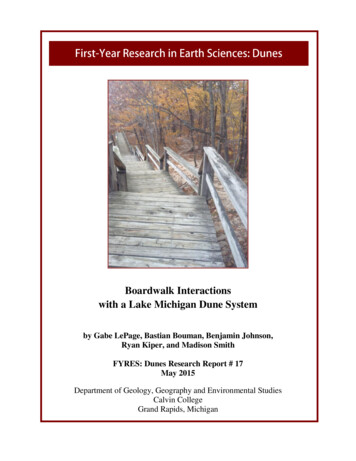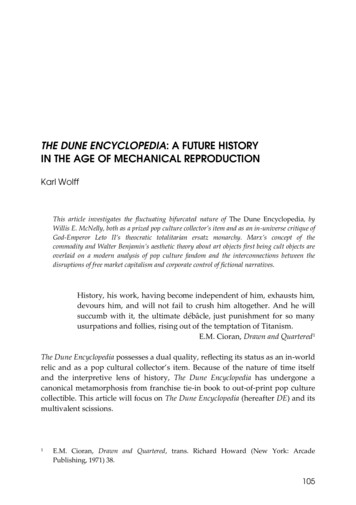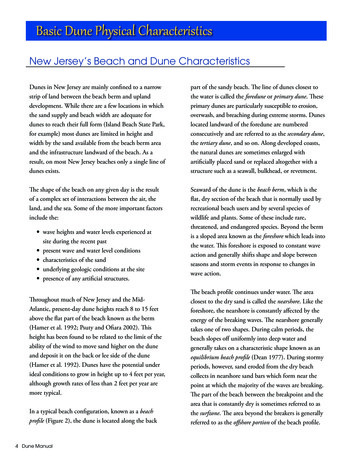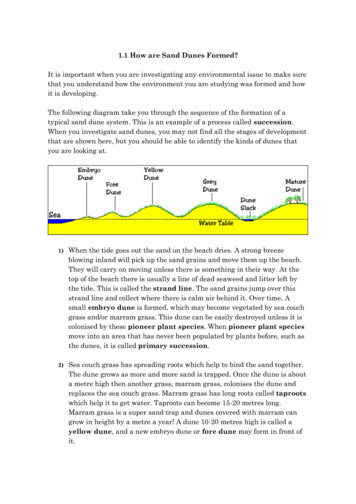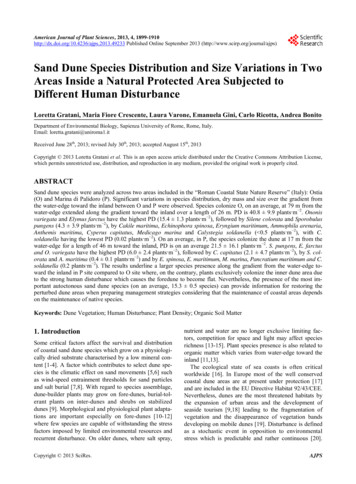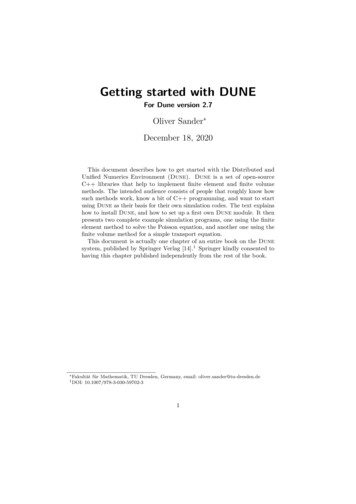
Transcription
Getting started with DUNEFor Dune version 2.7Oliver Sander December 18, 2020This document describes how to get started with the Distributed andUnified Numerics Environment (Dune). Dune is a set of open-sourceC libraries that help to implement finite element and finite volumemethods. The intended audience consists of people that roughly know howsuch methods work, know a bit of C programming, and want to startusing Dune as their basis for their own simulation codes. The text explainshow to install Dune, and how to set up a first own Dune module. It thenpresents two complete example simulation programs, one using the finiteelement method to solve the Poisson equation, and another one using thefinite volume method for a simple transport equation.This document is actually one chapter of an entire book on the Dunesystem, published by Springer Verlag [14].1 Springer kindly consented tohaving this chapter published independently from the rest of the book. Fakultät1 DOI:für Mathematik, TU Dresden, Germany, email: -31
Contents1 Installation of Dune1.1 Installation from Binary Packages . . . . . . . . . . . . . . . . . . . . .1.2 Installation from Source . . . . . . . . . . . . . . . . . . . . . . . . . . .3332 A First Dune Application2.1 Creating a new Module . . . . . . . . . . . . . . . . . . . . . . . . . . .2.2 Testing the new Module . . . . . . . . . . . . . . . . . . . . . . . . . . .5573 Example: Solving the Poisson Equation Using Finite Elements3.1 The main Method . . . . . . . . . . . . . . . . . . . . . . .3.1.1 Creating a Grid . . . . . . . . . . . . . . . . . . . . .3.1.2 Assembling the Stiffness Matrix and Load Vector . .3.1.3 Incorporating the Dirichlet Boundary Conditions . .3.1.4 Solving the Algebraic Problem . . . . . . . . . . . .3.1.5 Outputting the Result . . . . . . . . . . . . . . . . .3.1.6 Running the Program . . . . . . . . . . . . . . . . .3.2 Assembling the Stiffness Matrix . . . . . . . . . . . . . . . .3.2.1 The Global Assembler . . . . . . . . . . . . . . . . .3.2.2 The Element Assembler . . . . . . . . . . . . . . . .79911111314141516174 Example: Solving the Transport Equation with a Finite Volume Method204.1 Discrete Linear Transport Equation . . . . . . . . . . . . . . . . . . . . 214.2 The main Method . . . . . . . . . . . . . . . . . . . . . . . . . . . . . . 224.3 The evolve Method . . . . . . . . . . . . . . . . . . . . . . . . . . . . . 255 Complete source code of the finite element example286 Complete source code of the finite volume example33References35Oliver Sander, TU Dresden2
PreambleDune is a set of C libraries for the implementation of finite element and finitevolume methods. It is available under the GNU General Public License (Version 2)with the linking exception,2 which is the same license as the GNU C standardlibrary.The main public representation of Dune is its project homepage at www.dune-project.org. It has the latest releases, class documentations, general information, and ways tocontact the Dune developers and users.Many aspects of Dune have been published in scientific articles. We mention [2, 3]on the Dune grid interface, [1, 5, 6] on linear algebra, [9] on discrete functions, and[12] on the dune-typetree library. The Dune release 2.4 has been presented in [7],and the release 2.7 in [4].1 Installation of DuneThe first step into the Dune world is its installation. We have tried to make this aspainless as possible. The following instructions assume a Unix-style command shelland toolchain installed. This will be easy to obtain on all flavors of Linux and AppleOS X. On Windows there is the Windows Subsystem for Linux,3 or the cygwinenvironment.4Running the examples in this text requires eight Dune modules: dune-common,dune-geometry, dune-grid, dune-istl, dune-localfunctions, dune-uggrid, dunetypetree, and dune-functions.1.1 Installation from Binary PackagesInstallation is easiest when using precompiled packages. At the time of writing thisis the case for the Debian Linux distribution and many of its derivatives, but theremay be more. An up-to-date list is available on the Dune project web page atwww.dune-project.org. On a Debian-type system, typesudo apt-get install libdune-functions-dev \libdune-istl-dev \libdune-uggrid-devto install all those eight Dune modules. The ones not listed explicitly are addedautomatically. The Dune modules are then installed globally on the machine, and theDune build system will find them.1.2 Installation from SourceIf there are no precompiled packages available, or when working without sudo rights,then Dune has to be installed from the source code. First, download the code from the2 https://www.dune-project.org/about/license3 4 http://cygwin.comOliver Sander, TU Dresden3
Dune website at www.dune-project.org. It is recommended to download the releasetarballs, nameddune- modulename -X.Y.Z.tar.gzwhere modulename is one of common, geometry, grid, etc., and X.Y.Z is the releaseversion number. The code examples in this book require at least version 2.7.0.Those who need very recent features can also get the bleeding edge developmentversions of the Dune modules. The Dune source code is stored and managed using thegit version control software.5 The repositories are at https://gitlab.dune-project.org. To clone (i.e., download) the source code for one module typegit clone https://gitlab.dune-project.org/core/dune- modulename .gitwhere modulename is replaced by common, geometry, grid, localfunctions, oristl. The remaining three modules are available from the staging namespace:git clone d.gitgit clone ree.gitgit clone ions.gitThese eight commands create eight directories, one for each module. Each directorycontains the latest development version of the source code of the corresponding module.If desired, this development version can be replaced by a particular release version bycalling, e.g.,git checkout releases/2.7in the directory. See the git documentation for details.Suppose that there is an empty directory called dune, and that the sources of theeight Dune modules have been downloaded into this directory. When using the tarballs,these have to be unpacked bytar -zxvf dune- modulename -X.Y.Z.tar.gzfor each Dune module. To build them all, enter the dune directory and type6./dune-common/bin/dunecontrol cmake : makeThis configures and builds all Dune modules, which may take several minutes. Forbrevity, the two commands cmake and make can be called together as:./dune-common/bin/dunecontrol allOnce the process has completed, Dune can be installed by typing./dune-common/bin/dunecontrol make install5 https://git-scm.com6 Replacedune-common by dune-commmon-X.Y.Z when using the tarballs.Oliver Sander, TU Dresden4
This will install the Dune core modules to /usr/local, and requires root access.To install Dune to a non-standard location, a custom installation path can be set.For this, create a text file dune.opts, which should containCMAKE FLAGS "-DCMAKE INSTALL PREFIX /the/desired/installation/path"Then call./dune-common/bin/dunecontrol --opts dune.opts alland./dune-common/bin/dunecontrol --opts dune.opts make installThe dunecontrol program will pick up the variable CMAKE FLAGS from the options fileand use it as a command line option for any call to cmake, which in turn is used toconfigure the individual modules. The particular option of this example will tell cmakethat all modules should be installed to /the/desired/installation/path.Unfortunately, it has to be mentioned that as of Dune Version 2.7, working withinstalled modules is still not very mature, and may lead to build failures. As aconsequence of this, the installation of Dune modules is optional, and the Dune buildsystem will also accept non-installed modules as build dependencies.When using the dunecontrol program to manage further modules, it has to betold where to find the Dune core modules. This is done by prepending the path/the/desired/installation/path to the environment variable DUNE CONTROL PATH.Note, however, that if DUNE CONTROL PATH is set to anything, then the current directoryis not searched automatically for Dune modules. If the current directory should besearched then the DUNE CONTROL PATH variable has to contain :.: somewhere.72 A First Dune ApplicationDune is organized in modules, where each module is roughly a directory with apredefined structure.Each such module implements a C library that can be usedfrom other code. Although not necessary, however, it can be convenient to write newcode into a new Dune module, because that simplifies dependency tracking, and allowsfurther Dune modules to easily depend on the new code. The first step for this is tocreate a new Dune module template.2.1 Creating a new ModuleIn the following we assume again that there is a Unix-type command shell available,and that Dune has been installed successfully either into the standard location, or thatDUNE CONTROL PATH contains the installation path. To create a new module, Duneprovides a special program called duneproject. To invoke it, simply type7 Thedot denotes the current directory, and the colons are separators.Oliver Sander, TU Dresden5
duneprojectin the shell. If the program is not installed globally, use the version from dune-common/bin.The duneproject program will ask several questions before creating the module.The first is the module name. Any Unix file name without whitespace is admissible,but customarily module names start with a dune- prefix. To be specific we will callthe new module dune-foo.The next question asks for other Dune modules that the new module will dependupon. To help, duneproject has already collected a list of all modules it sees onthe system. These are the globally installed ones, and the ones in directories listedin the DUNE CONTROL PATH environment variable. After the installation describedabove one should see at least dune-common, dune-geometry, dune-grid, dune-istl,dune-localfunctions, dune-typetree, dune-uggrid, and dune-functions. Therequired ones should be entered in a white-space-separated list (and it is easy to addfurther ones later). For the purpose of this introduction please select them all.Next is the question for a module version number. These should start with X.Y (Xand Y being numbers), and can optionally end with a third number .Y or an arbitrarystring. This is followed by a question for an email address. This address will appear inthe file dune.module of the module (and nowhere else), and will be a point of contactfor others with an interest in the module. After this, the duneproject program exitsand there is now an blank module dune-foo: /dune: lsdune-fooA tool like the tree program can be used to see that dune-foo contains a smalldirectory tree: /dune tree dune-foodune-foo -- cmake ‘-- modules -- CMakeLists.txt ‘-- DuneFooMacros.cmake -- CMakeLists.txt -- config.h.cmake -- doc -- CMakeLists.txt ‘-- doxygen -- CMakeLists.txt ‘-- Doxylocal -- dune -- CMakeLists.txt ‘-- foo -- CMakeLists.txt ‘-- foo.hh -- dune-foo.pc.inOliver Sander, TU Dresden6
-- dune.module -- README‘-- src -- CMakeLists.txt‘-- dune-foo.cc7 directories, 15 filesThis tree contains: The cmake configuration files for the Dune build system, A text file dune.module, which contains some meta data of the module, a small example program in dune-foo.cc.2.2 Testing the new ModuleThe new module created by duneproject contains one C source code file src/dune-foo.cc. This is a small test program that allows to verify whether the modulehas been built properly. Configuring and building the module is controlled by thedunecontrol program again.The process is hardly any different from configuring and building the Dune coremodules as described in the previous section. Just move to the dune directory again,and typedunecontrol allin the shell. This will output lots of information while it runs, but none of itshould be of any concern right now (unless actual error messages appear somewhere). Once dunecontrol has terminated there is a new executable dune-foo indune-foo/build-cmake/src. Start it with /dune: ./dune-foo/build-cmake/src/dune-fooand it will printHello World! This is dune-foo.This is a sequential program.Congratulations! You have just run your first Dune program.3 Example: Solving the Poisson Equation Using Finite ElementsTo get started with a real example we will solve the Poisson equation with the finiteelement method.8 More specifically, we will compute the weak solution of the Poissonequation u 5(1)8 Readersthat are unsure about how the finite element method works should consult one of thenumerous textbooks on the subject.Oliver Sander, TU Dresden7
ΓNΓDΓDΩΓNFigure 1: A simple domain Ω with Dirichlet boundary ΓD (thick lines) and Neumannboundary ΓNon the L-shaped domain Ω (0, 1)2 \ [0.5, 1)2 , with Dirichlet boundary conditions(0on {0} [0, 1] [0, 1] {0},u (2)0.5 on {0.5} [0.5, 1] [0.5, 1] {0.5},and zero Neumann conditions on the remainder of the boundary. The domain andboundary conditions are shown in Figure 1.The example program solves the Poisson equation and outputs the result to a filewhich can be opened with the ParaView visualization software.9 The program code iscontained in a single file. We will not show quite the entire source code here, becausecomplete C programs take a lot of space. However, the entire code is printed inSection 5. Also, readers of this document in electronic form can access the source codefile through the little pin icon in the page margin. The easiest way to build the exampleis to copy the program file into dune-foo/src/, and then either to adjust the filedune-foo/src/CMakeLists.txt, or to simply replace the existing file dune-foo.ccwith the example, leaving CMakeLists.txt intact.A Dune example program for solving the Poisson equation can be written at differentlevels of abstraction. It could use many Dune modules and the high-level features. Inthat case, the user code would be short, but there would be no detailed control overthe inner working of the program. On the other hand, an example implementationcould be written to depend on only a few low-level modules. In this case more codewould have to be written by hand. This would mean more work, but also more controland understanding of how the programs works exactly.The example in this chapter tries to strike a middle ground. It uses the Dunemodules for grids, shape functions, discrete functions spaces, and linear algebra. Itdoes not use a Dune module for the assembly of the algebraic system—that part is9 http://www.paraview.orgOliver Sander, TU Dresden8
written by hand. Chapter 11.3 of [14] contains an alternative implementation that usesdune-pdelab to assemble the algebraic problem.At the same time, it is quite easy to rewrite the example to not use the Dunefunction spaces or a different linear algebra implementation. This is Dune—the user isin control. The finite volume example in Section 4 uses much less parts from Dunethan the Poisson example here does.3.1 The main MethodWe begin with the main method, i.e., the part that sits inint main (int argc, char** argv){[.]}It is located at the end of the file, and is preceded by a few classes that make up thefinite element assembler. As a first action, it sets up MPI 10 if available:275276// Set up MPI, if availableMPIHelper::instance(argc, argv);Note that this command is needed even if the program is purely sequential, because itdoes some vital internal initialization work.Remember that all Dune code resides in the Dune namespace. Hence type names likeMPIHelper need to be prefixed by Dune::. Since that makes the code more difficult toread, the example file contains the line28using namespace Dune;near the top. This allows to omit the Dune:: prefixes.3.1.1 Creating a GridThe first real action is to create a grid. The example program will use the trianglegrid shown in Figure 2. A grid implementation in Dune that supports unstructuredtriangle grids is the UGGrid grid manager.The grid itself is read from a file in the Gmsh format [10].11 The file can be obtainedby clicking on the annotation icon in the margin. The following code sets up atwo-dimensional UGGrid object with the grid from the Gmsh file l-shape.msh:284285286287288289290291constexpr int dim 2;using Grid UGGrid dim ;std::shared ptr Grid grid GmshReader Grid ::read("l-shape.msh");grid- globalRefine(2);using GridView Grid::LeafGridView;GridView gridView grid- leafGridView();10 TheMessage Passing Interface, used for distributed computing (see www.mpi-forum.org).11 http://gmsh.infoOliver Sander, TU Dresden9
Figure 2: Unstructured coarse grid for the domain used by the example. The actualsimulation happens on a grid that results from this one after two steps ofuniform refinement.The first two lines of this code block define the C data structure used for the finiteelement grid, and the third line loads the grid from the file into an object of this datastructure. Note that the grid dimension dim is a compile-time parameter. Line 288refines the grid twice uniformly, to get a result with higher resolution. For this part ofthe code to compile, it needs to have the lines89#include dune/grid/uggrid.hh #include dune/grid/io/file/gmshreader.hh at the top. The final two lines extract the result of the second refinement step as anon-hierarchical grid. This so-called leaf grid view is where the actual finite elementcomputation will take place on.Line 285 has introduced the type variable Grid to store the type of the grid datastructure that is used. This hints at one of the strengths of Dune: It is easy to usethe same code with different grid data structures. For the rest of the code, wheneverthe type of the grid is needed, we will only refer to Grid. This allows to change to,say, a structured cube grid by replacing only the definition of Grid and the subsequentconstructor call. Indeed, to replace the unstructured grid by a structured cube grid forthe unit square, replace Lines 285–286 byusing Grid YaspGrid dim ;auto grid std::make shared Grid ({1.0,1.0},{10, 10});//////////Upper right corner,the lower left oneis implicitly (0,0) hereNumber of elementsper directionThe YaspGrid class,12 from the file dune/grid/yaspgrid.hh, is the standard imple12 Thename means “Yet another structured parallel Grid”, for historical reasons.Oliver Sander, TU Dresden10
mentation of a structured cube grid in Dune.3.1.2 Assembling the Stiffness Matrix and Load VectorNow that we have a grid we can assemble the stiffness matrix and the load vector. Forthis we first need matrix and vector objects to assemble into. We get these with thelines299300301302303using Matrix BCRSMatrix double ;using Vector BlockVector double ;Matrix stiffnessMatrix;Vector b;Both BCRSMatrix and BlockVector are data structures from the dune-istl module,and obtained by placing1516#include dune/istl/bcrsmatrix.hh #include dune/istl/bvector.hh near the top of the program. It is, however, easy to use other linear algebra implementations instead of the one from dune-istl. That is another advantage of Dune.The next code block selects the first-order finite element space and the volume sourceterm:311312313Functions::LagrangeBasis GridView,1 basis(gridView);auto sourceTerm [](const FieldVector double,dim & x){return -5.0;};The space is specified by providing a basis for it. The closed-form volume source termis written as a C lambda object.To make the main method more readable, the actual assembly code has been putinto a subroutine, which is called next:316assemblePoissonProblem(basis, stiffnessMatrix, b, sourceTerm);The assemblePoissonProblem method will be discussed in Chapter 3.2.3.1.3 Incorporating the Dirichlet Boundary ConditionsAfter the call to assemblePoissonProblem, the variable stiffnessMatrix containsthe stiffness matrix A of the Laplace operator, and the variable b contains the weak righthand side. However, we still need to incorporate the Dirichlet boundary conditions. Wedo this in the standard way; viz. if the i-th degree of freedom belongs to the Dirichletboundary we overwrite the corresponding matrix row with a row from the identitymatrix, and the entry in the right hand side vector with the prescribed Dirichlet value.The implementation proceeds in two steps. First we need to figure out which degreesof freedom are Dirichlet degrees of freedom. Since we are using Lagrangian finiteelements, we can use the positions of the Lagrange nodes to determine which degreesof freedom are fixed by the Dirichlet boundary conditions. We define a predicate classOliver Sander, TU Dresden11
that returns true or false depending on whether a given position is on the Dirichletboundary implied by (2) or not. Then, we evaluate this predicate with respect to theLagrange basis to obtain a vector of booleans with the desired information:322323324325326327328329330331auto predicate [](auto x){return x[0] 1e-8 x[1] 1e-8 (x[0] 0.4999 && x[1] 0.4999);};// Evaluating the predicate will mark all Dirichlet degrees of freedomstd::vector bool dirichletNodes;Functions::interpolate(basis, dirichletNodes, predicate);In general, there is no single approach to the determination of Dirichlet degrees offreedom that fits all needs. The simple method used here works well for Lagrangespaces and simple geometries. However, Dune also supports other ways to find theDirichlet boundary.Now, with the bit field dirichletNodes, the following code snippet does the corresponding modifications of the stiffness matrix:338339340341342343344345346347348349// Loop over the matrix rowsfor (size t i 0; i stiffnessMatrix.N(); i ){if (dirichletNodes[i]){auto cIt stiffnessMatrix[i].begin();auto cEndIt stiffnessMatrix[i].end();// Loop over nonzero matrix entries in current rowfor (; cIt! cEndIt; cIt)*cIt (cIt.index() i) ? 1.0 : 0.0;}}Line 339 loops over all matrix rows, and Line 341 tests whether the row corresponds toa Dirichlet degree of freedom. If this is the case then we loop over all nonzero matrixentries of the row, using the iterator loop that starts in Line 346. Note how this loopis very similar to iterator loops in the C standard library. Finally, Line 347 setsthe matrix entries to the corresponding values of the identity matrix, by comparingcolumn and row indices.Modifying the right hand side vector is even easier. The previous loop could beextended to also overwrite the appropriate entries of the b array, but it is equallypossible to use the interpolation functionality of the dune-functions module a secondtime:354355356357auto dirichletValues [](auto x){return (x[0] 1e-8 x[1] 1e-8) ? 0 : 0.5;};Oliver Sander, TU Dresden12
358Functions::interpolate(basis,b,dirichletValues, dirichletNodes);The code defines a new lambda object that implements the Dirichlet value function,and computes its Lagrange interpolation coefficients in the b vector object. The fourthargument of the Functions::interpolate method restricts the interpolation to thosedegrees of freedom where the corresponding entry in dirichletNodes is set. All othersare untouched.At this point, we have set up the linear systemAx b(3)corresponding to the Poisson problem (1), and this system contains the Dirichletboundary conditions. The matrix A is stored in the variable stiffnessMatrix, andthe load vector b is stored in the variable b.3.1.4 Solving the Algebraic ProblemTo solve the algebraic system (3) we will use the conjugate gradient (CG) methodwith an ILU preconditioner (see [13] for some background on how these algorithmswork). Both methods are implemented in the dune-istl module, and require theheaders dune/istl/solvers.hh and dune/istl/preconditioners.hh, respectively.The following code constructs the preconditioned solver, and applies it to the 387388389390391392393394395396397398// Choose an initial iterate that fulfills the Dirichlet conditionsVector x(basis.size());x b;// Turn the matrix into a linear operatorMatrixAdapter Matrix,Vector,Vector linearOperator(stiffnessMatrix);// Sequential incomplete LU decomposition as the preconditionerSeqILU Matrix,Vector,Vector preconditioner(stiffnessMatrix,1.0); // Relaxation factor// Preconditioned conjugate gradient solverCGSolver Vector cg(linearOperator,preconditioner,1e-5, // Desired residual reduction factor50,// Maximum number of iterations2);// Verbosity of the solver// Object storing some statistics about the solving processInverseOperatorResult statistics;// Solve!cg.apply(x, b, statistics);Oliver Sander, TU Dresden13
After this code has run, the variable x contains the approximate solution of (3), bcontains the corresponding residual, and statistics contains some information aboutthe solution process, like the number of iterations that have been performed.3.1.5 Outputting the ResultFinally we want to access the result and, in particular, view it on screen. Dune itselfdoes not provide any visualization features (because dedicated visualization tools doa great job, and the Dune team does not want to compete), but the result can bewritten to a file in a variety of different formats for post-processing. In this examplewe will use the vtk file format [11], which is the standard format of the ParaViewsoftware.13 This requires the header dune/grid/io/file/vtk/vtkwriter.hh, and thefollowing code:403404405VTKWriter GridView vtkWriter(gridView);vtkWriter.addVertexData(x, on-fem-result");The first line creates a VTKWriter object and registers the grid view. The second lineadds the solution vector x as vertex data to the writer object. The string “solution”is a name given to the data field. It appears within ParaView and prevents confusionwhen there is more then one field. The third line actually writes the file, giving it thename getting-started-poisson-fem-result.vtu.3.1.6 Running the ProgramWith the exception of the stiffness matrix assembler (which is covered in the nextsection), the complete program has now been discussed. It can be built by typing makein the directory build-cmake. The executable getting-started-poisson-fem willthen appear in the build-cmake/src directory. After program start one can see theGmshReader object giving some information about the grid file it is reading, followedby the conjugate gradients iterations:Reading 2d Gmsh grid.version 2.2 Gmsh file detectedfile contains 43 nodesfile contains 90 elementsnumber of real vertices 43number of boundary elements 22number of elements 62 113 http://www.paraview.orgOliver Sander, TU Dresden14
Figure 3: Output of the Poisson example program, visualized as a height field224.68241e-050.717829232.2387e-050.478109 rate 0.596327, T 0.0213751, TIT 0.000929351, IT 23After program termination there is a file called getting-started-poisson-femresult.vtu in the build-cmake/src directory, which can be opened with, e.g., ParaView. It contains the grid and the solution function uh , and when visualized using aheight field, the result should look like Figure 3.3.2 Assembling the Stiffness MatrixWe now show how the stiffness matrix and load vector of the Poisson problem areassembled. The example program here does it “by hand”—it contains a completeassembler loop that uses only the Dune core modules and dune-functions. Thiswill illustrate how to use the grid and discrete function interfaces, and can be usedas a starting point for writing assemblers for other PDEs. Several additional Dunemodules provide full frameworks for finite element assemblers. Have a look at thedune-pdelab,14 dune-fem,15 and dune-fufem16 modules.14 www.dune-project.org/modules/dune-pdelab15 www.dune-project.org/modules/dune-fem16 www.dune-project.org/modules/dune-fufemOliver Sander, TU Dresden15
3.2.1 The Global AssemblerThe main assembler loop is contained in the method assemblePoissonProblem, whichis located above the main method in the example file. It has the signature191192193194195196197198template class Basis void assemblePoissonProblem(const Basis& basis,BCRSMatrix double & matrix,BlockVector double & b,const std::function double(FieldVector double,Basis::GridView::dimension ) volumeTerm)The method implements the standard finite element assembly loop; in particular, it inparticular, it assembles the individual element stiffness matrices, and adds them up toobtain the global stiffness matrix. As the first step, it retrieves the grid object fromthe finite element basis by202auto gridView basis.gridView();The object gridView is then the finite element grid that the basis is defined on.Next, the code initializes the global stiffness matrix. Before a BCRSMatrix objectcan be filled with values, it has to be given its occupation pattern, i.e., the set of allrow/column pairs where nonzero matrix entries may appear:208209210MatrixIndexSet occupationPattern;getOccupationPattern(basis, rix);For brevity we do not show the code of the getOccupationPattern method here,because it is very similar to the actual assembler loop. Consult the complete sourcecode in Section 5 to see it in detail.For all matrix entries that are part of the pattern, the next line then writes anexplicit zero into the matrix:215matrix 0;Finally, the vector b is set to the correct size, and filled with zeros as well:219220221222223// Set b to correct lengthb.resize(basis.dimension());// Set all entries to zerob 0;After these preliminaries starts the main loop over the elements in th
Running the examples in this text requires eight Dune modules: dune-common, ons,dune-uggrid,dune- typetree,anddune-functions.
